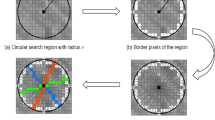Abstract
The texture of a machined surface generated by a cutting tool, with geometrically well-defined cutting edges, carries essential information regarding the extent of tool wear. There is a strong relationship between the degree of wear of the cutting tool and the geometry imparted by the tool on to the workpiece surface. The monitoring of a tool’s condition in production environments can easily be accomplished by analyzing the surface texture and how it is altered by a cutting edge experiencing progressive wear and micro-fractures. This paper discusses our work which involves fractal analysis of the texture of surfaces that have been subjected to machining operations. Two characteristics of the texture, high directionality and self-affinity, are dealt with by extracting the fractal features from images of surfaces machined with tools with different levels of tool wear. The Hidden Markov Model is used to classify the various states of tool wear. In this paper, we show that fractal features are closely related to tool condition and HMM-based analysis provides reliable means of tool condition prediction.
Similar content being viewed by others
References
Byrne G., Dornfeld D., Inasaki I., Ketteler G., König W., Teti R.(1995). Tool condition monitoring (TCM) – the status of research and industrial application. Ann. CIRP 44/2: 541–568
Mannan M.A., Kassim A.A., Jing M.(2000). Application of image and sound analysis techniques to monitor the condition of cutting tools. Pattern Recogn. Lett. 21, 969–979
Whitehouse D.J.(1971). Typology of manufactured surfaces. Ann. CIRP 18, 417–420
Kassim A.A., Mannan M.A., Jing M.(2000). Machine tool condition monitoring using workpiece surface texture analysis. Mach. Vis. Appl. 11, 257–263
Turner M.J., Blackledge J.M., Andrews P.R.(1998). Fractal Geometry in Digital Imaging. Academic, Newyork
Chaudhuri B.B., Sarkar N.(1995). Texture Segmentation using Fractal Dimension. IEEE Trans Pattern Anal. Mach. Intell. 17(1): 72–77
Sun Jing’ao, S., Anni, C.: Fractal based texture analysis for retrieval image data. In: APCC/OECC ’99, Joint Conference of 5th Asia-Pacific Conference on Communications (APCC) and 4th Opto-Electronics and Communications Conference (OECC), vol. 2, pp. 845–848 (1999)
Russ J.C.(1994). Fractal Surfaces. Plenum, New York
Li C.-G., Dong S., Zhang G.X.(2000). Evaluation of the anisotropy of machined 3D surface topography. Wear 237, 211–216
Thomas T.R., Rosén B.-G., Amini N.(1999). Fractal characterisation of the anisotropy of rough surfaces. Wear 232, 41–52
Rabiner L.R.(1989). A tutorial on hidden Markov models and selected applications in speech recognition. Proc. IEEE 77, 257–286
Heck L.P., McClellan J.H.(1991). Mechanical System using hidden markov models. Acoust., Speech Signal Process., IEEE Int. Conf., 3, 1697–1700
Atlas L., Ostendorf M., Bernard G.D.(2000). Hidden Markov models for monitoring machining tool-wear. Acoust. Speech Signal Process. IEEE Int. Conf. 6, 3887–3890
Author information
Authors and Affiliations
Corresponding author
Rights and permissions
About this article
Cite this article
Kassim, A.A., Mian, Z. & Mannan, M.A. Tool condition classification using Hidden Markov Model based on fractal analysis of machined surface textures. Machine Vision and Applications 17, 327–336 (2006). https://doi.org/10.1007/s00138-006-0038-y
Received:
Accepted:
Published:
Issue Date:
DOI: https://doi.org/10.1007/s00138-006-0038-y




